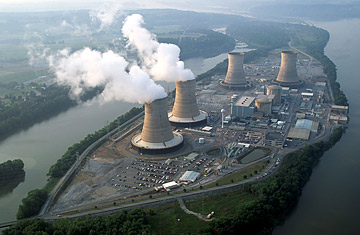
Three Mile Island Nuclear Power Plant
(5 of 11)
"I'll be honest about it, I don't know," replied Metropolitan Edison President Walter Creitz when reporters persisted. The first estimate came from William Dornsife, a nuclear engineer who had flown in the state helicopter. He put the radiation reading taken downwind from the plant at 1 millirem per hour—not an alarming or unalarming level. By 3 in the afternoon, Creitz put the reading at 2 to 3 millirems per hour, measured at the outer edge of the 200-acre plant site on the island.
By this time, in Harrisburg, Lieut Governor William Scranton III expressed alarm that he might be getting inaccurate reports from plant officials. He told reporters: "This situation is more complex than the company first led us to believe. Metropolitan Edison has given you and us conflicting information." Indeed federal investigators from the nearby headquarters of the NRC in King of Prussia reported later in the day that radio activity had been detected as far as 16 miles from the plant, and claimed that radiation within the reactor containment building had risen to a startling 1,000 times its normal level. At one point operators in the nearby control room had to put on protective gas masks.
By Thursday an NRC official was calling the plant failure "one of the most serious nuclear accidents to occur in the U.S." Nevertheless, at a jammed press conference in Hershey, an uncomfortable Herbein still contended: "We didn't injure anybody. We didn't overexpose anybody. We didn't kill a single soul. The release of radioactivity off-site was minimal." He said only 15 employees had even been exposed to enough radiation to require them to take showers and discard the clothes they had worn at the time of the accident. His biggest worry seemed to be what to do with the 250,000 gal. of contaminated water on the floor of the reactor building.
Inescapably parodying The China Syndrome, Herbein expressed concern over the fact that the plant could be shut down for several weeks and over the multimillion dollar cost of decontaminating the two buildings. He did not rule out the possibility that consumers might have to shoulder the expense. Both company officials and investigators from NRC again assured the public that the reactor was cooling and should be down to its normal shut-off temperature within a day.
By this time, hundreds of reporters from as far away as Britain and Japan had rushed to Three Mile Island. Said a genuinely startled Creitz: "We're simply aghast at the number of people we've had to deal with." The visitors found the residents, as well as workers at the plant, surprisingly calm. "There was an accident, not a disaster," insisted William Metzger, a maintenance man on Three Mile Island. "I'm not afraid. I think these plants are safe." Asked Co-Worker William Wilsbach: "Do you think I'd work here if I thought it was dangerous?" In Harrisburg, Secretary Margaret Duffy dismissed the whole fuss as "much ado about nothing." Mary Anne Koehler, who is seven months pregnant, said she would worry a lot more about damage to her unborn child "if I worked in a chemical plant."
